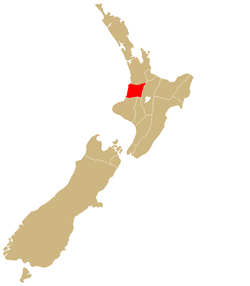- Ngāti Maniapoto
-
Ngāti Maniapoto Iwi of New Zealand 
Rohe (location) Waikato-Waitomo Waka (canoe) Tainui Population 33,627 Ngāti Maniapoto is an iwi (tribe) based in the Waikato-Waitomo region of New Zealand's North Island. It is part of the Tainui confederation, the members of which trace their whakapapa (genealogy) back to people who arrived in New Zealand on the waka (canoe) Tainui. The 2006 New Zealand census shows the iwi to have a membership of 33,627 [1], making it the 7th biggest iwi in New Zealand.
Contents
Marae
There are many marae in the Ngāti Maniapoto area, one of the notable ones being Te Tokanga Nui A Noho [2] at Te Kuiti in the King Country. This marae was gifted to Ngāti Maniapoto by Te Kooti, a Rongowhakaata tribesman who sought refuge from the British colonial army during the New Zealand land wars. Of equal significance but less publicly known is Tiroa Pā where the last Io whare wānanga (traditional study centre) was held in a specially crafted whare called Te Miringa Te Kakara. The other whare wānanga was near present-day Piopio and was called Kahuwera. It stood on the hill of the same name and commanded a panoramic view of the Mokau River valley across the Maraetaua block.
Recent history
Ngāti Maniapoto was the iwi that got Tainui and the Kingitanga involved in the land wars (1845-72),by going to fight the British soldiers at Taranaki during the first Taranki war. It was a move not taken lightly but one which was underpinned with a level of strategic foresight. The Maniapoto chiefs especially Rewi Manga Maniapoto, knew that if the colonists got a foothold in the south it would only be time before they would establish a stronghold in the north and be positioned on each side of Waikato-Maniapoto. This would leave the King and his Waikato allies as well as Ngāti Raukawa and Ngāti Maniapoto open on both the north and southern borders, something that the battle-hardened Rewi Manga Maniapoto could not accept.
Ngāti Maniapoto had traditionally been involved in attacking Taranaki iwi so this represented a change in loyalties. The isolated Waikato-Waitomo or Nehenehenui hill country region which they controlled was often a retreating point for allied Kingitanga iwi to fall back to after being defeated in a series of seven pitched battles and multiple skirmishes with the British and NZ forces.
After the Waikato war, Taonui Hikaka (a Junior Chief) and the paramount warrior Rewi Manga Maniapoto and Wahanui negotiated with the colonial government to allow the main trunk railway line through Ngāti Maniapoto territories. This was done because of word that the Māori King Tāwhiao and Te Kooti were also trying to negotiate with the British colonial government for rail access and to set up Native Land Courts throughout the region. This could have meant that Ngāti Maniapoto would become landless. It is said that when Tāwhiao found out what they had done, he angrily threw his hat onto a survey map of the Ngāti Maniapoto territory and claimed the area where the hat fell as Te Rohe Pōtae, the district of the hat. To day this territory is called the King Country, in reference to this event.
However, tensions grew between Ngāti Maniapoto chiefs and the King Tāwhiao because of what could be perceived as a transgressions of authority. It was widely understood that chiefs in Ngāti Maniapoto were only answerable to their consituent hapu, although they supported the notion and principles of the Kingitanga, this did not mean they could or even wanted to surrender their rangatiratanga or chieftainship. After all, the King was a king by virtue of the approval of the chiefs. While the King was resident in Ngāti Maniapoto territory as a guest, the mana of Ngāti Maniapoto reigned supreme in their rohe and the king did not have authority over their land.
Famous people
- Dame Kiri Te Kanawa - Opera Singer
- Temuera Morrison - Television and Film Actor
- Dame Rangimarie Hetet - famous weaver and fabric artist
- Dr Pei Te Hurinui Jones - Famous Maori academic and writer
- Taonui Hikaka - Paramount chief of Ngāti Maniapoto in the latter half of the 19th century
- Rewi Manga Maniapoto - Warrior Chief who was famous in battle with the British Imperial Army.
- Wahanui - Warrior Chief famous for his diplomacy skills in negotiation.
- Tiki Taane - live soundman of Salmonella Dub
- Richard Kahui - All Black
- Homai Uerata - Radio DJ for Raukawa FM
- Wiremu Te Awhitu - First Māori Catholic Priest.
- Sandor Earl - NRL Player for the Penrith Panthers
- Rodney Bell
External links
- Maniapoto Trust Board
- Ngāti Maniapoto in Te Ara - the Encyclopedia of New Zealand
Categories:- Iwi and hapu
Wikimedia Foundation. 2010.

